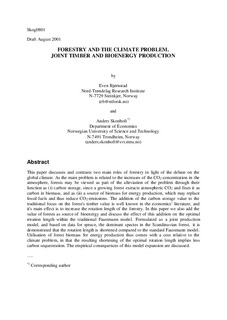Forestry and the climate problem: Joint timber and bioenergy production
Others
Permanent lenke
http://hdl.handle.net/11250/242641Utgivelsesdato
2001Metadata
Vis full innførselSamlinger
Sammendrag
This paper discusses and contrasts two main roles of forestry in light of the debate on the global climate. As the main problem is related to the increases of the CO2-concentration in the atmosphere, forests may be viewed as part of the alleviation of the problem through their function as (i) carbon storage, since a growing forest extracts atmospheric CO2 and fixes it as carbon in biomass, and as (ii) a source of biomass for energy production, which may replace fossil fuels and thus reduce CO2-emissions. The addition of the carbon storage value to the traditional focus on the forest's timber value is well known in the economics' literature, and it's main effect is to increase the rotation length of the forestry. In this paper we also add the value of forests as source of bioenergy and discuss the effect of this addition on the optimal rotation length within the traditional Faustmann model. Formulated as a joint production model, and based on data for spruce, the dominant species in the Scandinavian forest, it is demonstrated that the rotation length is shortened compared to the standard Faustmann model. Utilisation of forest biomass for energy production thus comes with a cost relative to the climate problem, in that the resulting shortening of the optimal rotation length implies less carbon sequestration. The empirical consequences of this model expansion are discussed.
